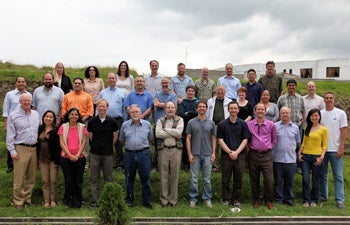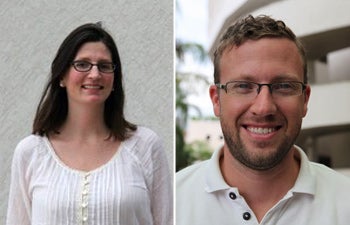Understanding Pentecostalism’s Global Impact
Pentecostalism — a religious movement that began in a warehouse on Azusa Street in Los Angeles in 1906 — has emerged as a fast-growing minority religion in the developing world, gaining popularity in the Southern hemisphere and becoming a competitor to traditional denominations.
Led by USC Dornsife’s Donald Miller, scholars worldwide are investigating the religion that has captured the attention of citizens throughout the world under the Pentecostal and Charismatic Research Initiative (PCRI). Now in their second year of research, they have reported preliminary findings that provide insight to the movement’s growth and its impact on civil society and politics. PCRI researchers met for the first time this summer in Quito, Ecuador, to share preliminary findings and forge collaborations.
“Pentecostalism increasingly is not an other-worldly sectarian religion, but it’s starting to have genuine political impact in some countries,” said Miller, Leonard K. Firestone Professor of Religion and executive director of the Center for Religion and Civic Culture (CRCC) in USC Dornsife.
CRCC staff have been responsible for overseeing all aspects of the initiative. From distributing the request for proposals internationally, reading approximately 500 letters of intent and overseeing the evaluation by expert judges of 100 full proposals. Staff also developed subcontracts with 21 institutions around the world and planned the conference in Quito.

PCRI researchers, USC staff and Kimon Sargeant (orange shirt),vice president of human sciences at the John Templeton Foundation at the PCRI conference in Quito, Ecuador.
“In some ways the fun has only begun,” Miller said. “We will be working with grantees to assist them in disseminating their findings beyond the usual outlets of journal articles and university press books.”
PCRI researchers are helping decipher the movement’s attraction to followers and providing a deeper look at the religion.
“Their worship is extremely vibrant,” Miller said. “One reason these churches are growing is because they are able to integrate mind and body in their religious experiences, and they’re being incredibly creative in responding to the needs of their people.”
Several elements employed by congregations may add to the religion’s appeal, findings revealed. The establishment of social programs meant to alleviate poverty, provide economic development and education and medical care in surrounding communities are potential reasons for the movement’s draw.
Miller hatched the idea to create a grant allowing for scholarly research in 23 countries after his successful research on Pentecostalism with Tetsunao Yamamori of Food for the Hungry, an international aid organization. That effort resulted in a book Miller co-authored with Yamamori, Global Pentecostalism: The New Face of Christian Social Engagement (University of California Press, 2007).
The PCRI was established in 2010 with a $6.9 million grant from the John Templeton Foundation. The initiative provides grants totaling $3.5 million to five regional centers and 16 individual scholars and their teams to conduct research in 23 countries including Africa, Asia, Latin America and the former Soviet Union. The PCRI is also supporting the creation of a digital archive in conjunction with the USC Digital Library and conducting research on Pentecostalism and charismatic Christianity in Los Angeles.

PCRI researcher Andrew Johnson, a doctoral candidate at the University of Minnesota, observed inmates in Brazil participate during daily worship services. Photo by Phillip Anema.
For the past year scholars have investigated the movement’s growth in specific countries as well as its impact on civil society and politics. Miller said scholars are reporting strong evidence that Pentecostalism is continuing to grow exponentially with many indigenous Pentecostal churches throughout the globe, spawning daughter churches.
Such congregations have sprouted in various countries from Africa to the former Soviet Union with services ranging from small gatherings in private apartments to large-scale theaters. With 500 million worldwide followers, researchers will provide insight to help the public understand the significance of Pentecostalism on cultural, social and religious grounds.
Karrie Koesel, assistant professor of political science at the University of Oregon, observed the growing presence of Pentecostal and charismatic Christians in China and will do the same in Russia. Through her project, “Where Faith Thrives: The Rise of Pentecostal and Charismatic Christianity in Russia and China,” Koesel is examining how the religious groups are able to flourish in countries where religious expression is limited.
“I think it is interesting and counterintuitive that religious groups on the political margins are growing in spite of all the challenges and hurdles facing them,” Koesel said. “You literally would have no idea that you could be surrounded by dozens of house churches unless perhaps you overheard a worship service.”
She completed the first portion of her field work this year in China, where she observed several illegal underground house churches. Unlike Russia where Pentecostal congregations can publicize their services, China continues to struggle with making space for religious mobilization that is not one of the officially recognized religions.
Koesel will travel to Russia for the second half of her field work where she will focus on several Pentecostal churches that have grown dramatically in small communities.
“The house church movement in China is large and is growing. However, since it is not officially recognized by the Chinese government, researchers must be extremely careful that they do not compromise the identity of house church members,” Miller said. “Karrie’s research is groundbreaking in describing the unique cell structure of this movement, which accounts for its growth as well as its ability to avoid government scrutiny.”

Left: Karrie Koesel, assistant professor of political science at the University of Oregon, will observe the growing presence of Pentecostal and charismatic Christians in China and Russia. Right: Andrew Johnson, a doctoral candidate at the University of Minnesota, is investigating how inmates convert prison into a sacred space and is looking at Pentecostalism’s larger social impact on Brazilian society. Photo by Don Miller.
In his research, Andrew Johnson, a doctoral candidate at the University of Minnesota, observed inmates in Brazil participate in daily worship. He did participant-observer research in a prison, sleeping in a 10-foot by 10-foot room with three cellmates. He watched as prisoners gathered in a room that held 80 to 100, sang and prayed alongside one another.
In his study, “Religion Behind Bars: Pentecostalism in Brazilian Prison and the Social Consequences of Religious Prisoners,” Johnson is one of 16 scholars investigating the religious movement that has grown exponentially in the developing world. Fascinated with the growing role of Christianity in Brazilian prisons the past 15 to 20 years, Johnson is investigating how inmates convert prison into a sacred space and is looking at Pentecostalism’s larger social impact on Brazilian society.

In his research on Brazilian prisons, Andrew Johnson witnessed how congregation members become an extension of family. Pentecostal prisoners look after one another often taking offerings to purchase basic necessities for fellow members. Photo by Phillip Anema.
In the country where gangs and Pentecostal churches are the strongest institutions in impoverished neighborhoods, it is common for prison administrators to call on Pentecostal pastors to negotiate hostage situations or mediate prison riots. Through inmate interviews and observation, Johnson has found Pentecostal prisoners often act as one, forming their own churches, selecting a pastor, deacon and organizing a worship team. At night they meet in a designated cell to pray together and will often take up offering for those inmates who are unable to afford basic necessities such as toilet paper and soap. Congregation members become an extension of family.
“Looking at global Pentecostalism in a unique space — prison — provides a glimpse of how people in extraordinarily difficult circumstances use this faith to try to live moral and dignified lives,” Johnson said. “It will be able to help us understand why these kinds of parallel power structures like gangs and Pentecostal churches are strongest in poor urban areas.”
“Andrew has spent considerable time doing participant-observer research within prison settings, documenting the personal transformation of men and women who have committed violent crimes,” Miller said. “During a recent visit to Rio de Janeiro I witnessed firsthand one of the church-sponsored facilities where ex-prisoners continue their rehab and found it truly remarkable.”
PCRI researchers will convene once more upon the grant’s conclusion in August 2012 in Nairobi, Kenya, to present their findings. As they did while writing Global Pentecostalism, Miller and Yamamori will travel to select sites to pen an overview book on all the projects. Miller is in negotiation with a major university press regarding a book series on Pentecostal and charismatic Christianity stemming from research funded by the PCRI.
“We want to genuinely try to develop scholarship in the developing world which would stand on its own after our grant period ends,” Miller said. “This research is enabling the CRCC to create our network of global scholars and I would like to expand that network through future grants so that we can be a hub for large scale research projects on religion.”
For more information on the Center for Religion and Civic Culture, visit crcc.usc.edu.